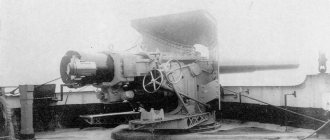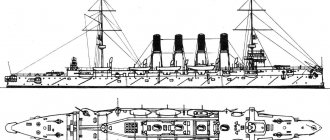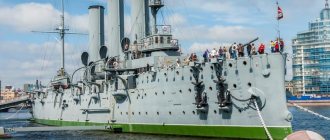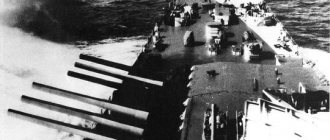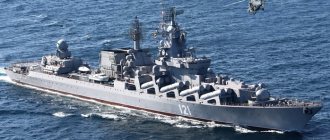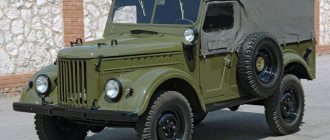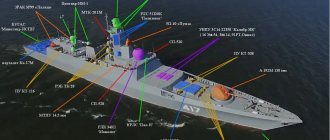Project history
"Bogatyr" is an armored cruiser, designed at the beginning of the 20th century. The reason for its development was the same Japan, which at that time was exciting with its power and strength. Two years before the start of the new century, the Japanese created a program to equip and increase the power of their fleet.
Russia decided not to lag behind, so with the project “For the needs of the Far East” it began to design ships that could gain superiority over the enemy. Initially, it was planned to create two types of armored cruisers with different displacements. But then the program slowed down due to the fact that the plans of 1895 were not fulfilled.
The Maritime Ministry decided to seek help from shipbuilding firms abroad. After holding a small competition, Russia drew attention to the project presented by Germany. The country presented a ship with powerful artillery and a displacement of 6,250 tons.
Implementation of the planned
They began building the cruiser the very next year after drawing up the project plan. At the end of 1899, the lead ship was laid down, with the bright and powerful name “Bogatyr”. Construction of the future sea fighter has begun in full swing. While working on the ship, the Germans decided to transfer 3 more drawings to Russia, thanks to which armored cruisers of the Bogatyr type were to appear.
Construction did not go smoothly. Problems constantly arose with the supply of parts and directly with the design. Both sides argued all the time and could not agree on the final project even during its implementation. Because of this, the deadlines were constantly postponed, and the ship was not ready.
At the beginning of 1901, the cruiser "Bogatyr", the drawings of which were successfully turned into a powerful vessel, took to the water. After conducting a lot of tests, including speed tests, the ship was handed over to the customer in 1902, and it was able to go into battle.
Far East
The course to the Far East was decided after the cruiser “Bogatyr” became a full-fledged combat ship and underwent shooting training. Two squadron battleships and two cruisers went to the Pacific Ocean with him.
Only 2 years later the ship was able to enter into real battle. The entire “Bogatyr” squad was dressed in olive color, Russia declared war with Japan. Cruising was begun. This process was stopped by the sinking of the coastal steamer, the capture of the crew and a storm.
The next cruising only triggered the attack of the Japanese fleet, and already in March a detachment of 4 cruisers and 2 destroyers bombarded Vladivostok. Over time, more help from 15 ships sailed to him. The Vladivostok detachment was supposed to distract attention, which it did very well.
At the end of April, the cruiser "Bogatyr", whose weapons were one of the most powerful in the detachment, joined the cruisers "Gromoboy" and "Russia". Two destroyers were sent with them. It was quiet cruising that produced excellent results.
The first injury the ship received occurred in May. The visibility of the sea was extremely low, despite this, the cruiser moved at a speed of 10 knots. A team of officers tried to reason with the captain, but all persuasion was in vain. As a result, the Bogatyr was damaged by rocks near Cape Bruce. This event was sad for the entire crew. In addition to the fact that the ship received holes and several compartments were flooded, it was not able to get off the rocks on its own.
The help that arrived that day did not bring results. The weather also did not play into the sailors' hands. A force 10 storm forced the evacuation of the entire “heroic” crew. After the storm, a mechanic and workers arrived on the ship. The damage was severe. Almost half of the compartments were flooded, and the ship turned around on the rocks.
It took a month and a half to remove the ship from the rocks. All this time he was unloaded until he was completely “liberated.” Until the end of the war, the towed Bogatyr remained in the port of Vladivostok. The ship was still destined to meet the Japanese, but in peacetime. "Bogatyr" accompanied the cruiser "Russia" to the port of Racine. There were two opposing admirals on the ship. Here they discussed the terms of the peace treaty, which they later concluded in Portsmouth.
"Bogatyrs" of the Black Sea Fleet
Bogatyr-class cruisers are considered one of the most successful armored cruisers of the early 20th century.
Initially, they were built to conduct raider operations on remote communications of the British Empire (in alliance with the German navies), but, ironically, they were forced to fight in the confined spaces of the Baltic and Black Sea against the German and Turkish fleets.
By the end of the 19th century, the leading military -maritime powers came to the conclusion that it was necessary to have cruisers in the fleet - ships capable of destroying enemy transport ships, as well as performing squadron service. According to naval theorists, the fleet needed three types of cruisers:
- large cruisers (in later sources appear as “heavy” or “armored”), intended for operations on ocean communications;
- medium cruisers (in later sources appear as “light” or “armored”), operating close to their own naval bases;
- small cruisers (in later sources appear as “auxiliary” or “advice notes”) - high-speed ships intended for reconnaissance in squadrons of linear forces.
The naval doctrine of the Russian Empire was generally consistent with global trends. Thus, the classification introduced in 1892 provided for the presence in the fleet of cruisers of the 1st (divided into armored and armored cruisers) and 2nd ranks. The shipbuilding programs adopted in Russia in 1896 and 1898–1904 provided for the construction of twenty cruisers of all types for the Baltic Fleet and two cruisers for the Black Sea Fleet. The bulk of the cruisers of the Baltic Fleet were intended for the Pacific Ocean squadron created within it (since May 12, 1904 - the 1st squadron of the Pacific Fleet). The Naval Ministry received the necessary funds, but spent them rather irrationally, eventually building only eighteen cruisers. The failure of the program was greatly facilitated by the Marine Technical Committee (MTK). As a result of the constant change in its requirements for the tactical and technical characteristics of new ships, the fleet eventually received six armored cruisers with a total displacement of 11,000–15,000 tons of four different types, nine armored cruisers with a total displacement of 7,000–8,000 tons of four different types and four armored cruisers with a total displacement 3000 tons of three different types.
The increase in the number of armored cruisers built due to a decrease in the number of armored cruisers is usually associated with the course of the Navy Ministry to abandon the previously planned cruising war against the British Empire in favor of a plan to create an armored squadron that would be superior in strength to the Japanese fleet. The appearance of armored cruisers with a displacement of 3,000 tons, optimally adapted for operations on Japanese trade routes close to Russian naval bases, is fully consistent with this assumption. But the appearance of larger (so-called “7000-ton”) cruisers does not fit into the anti-Japanese doctrine - ships armed with 152-mm guns were too powerful to fight Japanese cruisers of the 2nd rank and too weak to fight turret-mounted armored cruisers , armed with 203 mm guns. The emergence of 7,000-ton armored cruisers was more a consequence of numerous compromises aimed at creating a universal cruiser to fight any potential enemy than a fully meaningful and calculated decision. Such attempts to create the “ideal weapon”, as a rule, end in a waste of time and resources, but, fortunately, the largest series of 7000-ton cruisers were built, definitely the most advanced cruisers of the “Bogatyr” type, which were to a certain extent ahead of their time and anticipated the advent of in the 30s, tower cruisers of the so-called “Washington” type.
Performance characteristics
The final version of the “Program for a cruiser of 6,000 tons of displacement”, prepared for April 13, 1898, formulated the basic requirements for the ship:
- displacement - 6000 tons;
- cruising range - about 4000 miles at a speed of 10 knots;
- speed – at least 23 knots;
- the use of 152-mm Kane cannons with a barrel length of 45 calibers as the main artillery armament (the method of placing guns was not regulated);
- armoring the deck and conning tower.
It is interesting that the first ships of the new type were laid down in May 1897 - almost a year before the final version of the “Program” was adopted.
Due to administrative confusion (Russian admirals were never able to finally agree on the requirements for a new type of cruiser) and short construction times, which forced them to turn to various shipbuilding companies, the Imperial Navy, as mentioned earlier, received nine armored cruisers of four different types. Armored cruisers built according to the “Program for a cruiser of 6000 tons of displacement”
| Cruiser type | "Pallada" | "Varangian" | "Askold" | "Bogatyr" |
| Project developer | Baltic Plant (Russia) | William Cramp and Sons (Philadelphia, USA) | Germaniawerft (Kiel, Germany) | Vulcan AG (Stettin, Germany) |
| Date of laying of the lead ship | 23.05.1897 | 10.05.1899 | 8.06.1899 | 9.12.1899 |
| Number of ships built | 3 | 1 | 1 | 4 |
| Total displacement, tons | 7271–7900 | 7220 | 7280 | 7790 |
| Travel speed, knots | 20 | 23,75 | 23,8–24,5 | 23-24 |
| Cruising range | 3700 miles at 10 knots | 4280 miles at 10 knots | 4100 miles at 10 knots | 4900 miles at 10 knots |
| Placement of main caliber guns | Open deck installations | Open deck installations | Panel deck installations | Tower, casemate and panel deck installations |
Diagram of the cruiser “Memory of Mercury” as of 1907 Source: forum.worldofwarships.ru
The construction of Bogatyr-class cruisers was carried out by four different shipyards (one German and three Russian).
Bogatyr-class armored cruisers
| Ship | Shipyard | Bookmark date | Launch date | Commissioning date |
| "Bogatyr" | Vulkan AG (Stettin, Germany) | 9.12.1899 | 17.01.1901 | 7.08.1902 |
| "Cahul" | Nikolaev Admiralty (Nikolaev, Russia) | 23.08.1901 | 20.05.1902 | 1905 |
| "Ochakov" | Lazarevskoye Admiralty (Sevastopol, Russia) | 13.08.1901 | 21.09.1902 | 10.06.1909 |
| "Oleg" | New Admiralty (St. Petersburg, Russia) | 6.07.1902 | 14.08.1903 | 12.10.1904 |
The hull of the cruiser "Vityaz", laid down in 1900 (date of ceremonial laying - June 4, 1901) at the Galerny Ostrov shipyard in St. Petersburg, was destroyed by a powerful fire on June 13, 1901, which led to the need to lay down the cruiser "Oleg" instead " The cruisers "Bogatyr" and "Oleg" were built for the Baltic Fleet, and the "Cahul" and "Ochakov" for the Black Sea Fleet.
Design
Bogatyr-class cruisers had a three-tube silhouette with a short forecastle and poop deck. Structurally, Russian-built ships were somewhat different from the lead cruiser, which was caused by both objective (during the construction process the range of weapons was changed) and subjective nature (strange as it may sound from the point of view of modern realities, but at the beginning of the twentieth century there was no such concept both the internal design specifications and the parts produced by different contractors differed significantly from each other). The visible difference between the “Black Sea” cruisers and the “Baltic” ones was the smooth line of the stem without thickening in its middle part.
Cruiser "Memory of Mercury" (until March 25, 1907 - "Cahul"), 1917 Source: ru.wikipedia.org
The cruiser "Ochakov" at the outfitting wall.
Sevastopol, 1905 Source: ru.wikipedia.org Tactical and technical characteristics of armored cruisers of the “Bogatyr” type
| Ship | "Bogatyr" | "Cahul" | "Ochakov" | "Oleg" |
| Total displacement, t | 7790 | 7790 | 7790 | 8250 |
| Length, m | 134,1 | 134 | 134 | 134,1 |
| Width, m | 16,6 | 16,6 | 16,6 | 16,6 |
| Draft, m | 6,29 | 6,3 | 6,3 | 6,8 |
Armament
Initially, during the construction of armored cruisers, the MTK assumed the installation of:
- main caliber artillery (bow and stern 203 mm and side 152 mm guns);
- 47- and 75-mm “mine-resistant” guns;
- 37- and 47-mm Hotchkiss boat guns;
- two surface (course and stern) and two underwater 381-mm torpedo tubes.
However, the Admiral General of the Russian Fleet, Grand Duke Alexey Alexandrovich, ordered the unification of the main caliber guns, replacing the 203 mm guns with 152 mm ones. The ideologist of this decision was the authoritative naval artilleryman N.V. Pestich, who believed that “a hail of shells from 152-mm cannons will cause more damage to the enemy than fewer hits from 203-mm and other larger guns.”
.
As a result, the Bogatyr-class cruisers received twelve 152-mm Kane cannons with a barrel length of 45 calibers (four in two-gun bow and stern turrets, four in casemates on the upper deck (side of both masts) and four in sponsons in the central part of the ship) with a total ammunition load of “2160 separate rounds”
.
Aft 152-mm turret of the cruiser “Ochakov” Source: nashflot.ru
The rejection of 203-mm guns is often criticized by experts, citing the opinion of the commander of the cruiser "Cahul", Captain 1st Rank S.S. Pogulyaev, who during the First World War insisted on replacing the two-gun 152-mm turrets with single-gun 203-mm turrets. According to Pogulyaev, after such changes, “ the cruiser even met with the Goeben”
(referring to the German battle cruiser Geben - author’s note.)
will not have that offensive, heavy character of complete defenselessness to which a ship armed only with six-inch guns is doomed
. To a certain extent, we can agree with both points of view. On the one hand, Pestich was right, since the experience of the Russian-Japanese War showed that fire adjustments can only be made with a salvo of at least four guns, which made the two 203-mm Bogatyr guns suitable for firing only when pursuing or breaking away from enemy and excluded their use in a broadside salvo. On the other hand, Pogulyaev is right, since already during the First World War it became clear that it was impossible to conduct salvo fire jointly (centrally) with turret and deck guns for the following reasons:
- different rates of fire for turret and casemate guns due to differences in the methods of aiming them;
- more difficult adjustments to the firing of turrets due to the dispersion of projectiles caused by their rotation;
- differences in adjustments when controlling fire due to the use of different types of sights;
- different firing ranges during lethal fire due to the inability of tower elevators to supply projectiles with ballistic tips.
Alternating targeted salvoes of turret guns with salvoes of deck guns turned out to be practically impossible - the turrets required test salvos, and a special fire manager was needed for them. As a result, the bow and stern turrets were used only when pursuing or separating from the enemy (in such cases, the presence of more powerful 203 mm guns would have been preferable). Thus, we can say that Pestich’s theoretically correct idea was incorrectly implemented in practice. The anti-mine artillery, which consisted of twelve 75-mm Kane guns with a barrel length of 50 calibers (eight at the level of the upper deck, four above the casemates) with a total ammunition load of “3,600 unitary cartridges,” also caused no less criticism.
and six 47 mm Hotchkiss guns. A striking example of the low effectiveness of 75-mm guns is the attempt by Russian cruisers to shoot Turkish troops near the port of Rize during the First World War. After twenty-eight ineffective shots (according to the report, 75-mm shells that hit the water at the waterline did not explode, but ricocheted and exploded on the shore), the Laibs were destroyed by 152-mm guns. In addition to the above-mentioned guns, the cruisers received two 37- and 47-mm Hotchkiss boat guns.
Attempts to change the artillery armament of the new cruisers began literally immediately after the project was approved. Of the many proposed projects, several of the most noteworthy should be highlighted. Thus, already on September 20, 1899, the Baltic Plant presented a project that provided for the turret placement of all twelve 152-mm guns. This solution made it possible to significantly increase the effectiveness of main caliber artillery through the use of central aiming. However, this undoubtedly progressive project was rejected due to the impossibility of producing the required number of towers in a timely manner. After the Russo-Japanese War, the commander of the cruiser "Oleg", Captain 1st Rank L.F. Dobrotvorsky, proposed dismantling four onboard 152 mm and all 75 mm guns, replacing the casemate 152 mm guns with American 178 mm guns. Dobrotvorsky’s project also included armoring casemates and installing an 89-mm armor belt, which, in essence, turned the ship from an armored cruiser into an armored one. The Navy Ministry recognized this project as too radical, limiting itself to more conservative changes. At a certain stage, the project of A. A. Bazhenov to replace eight 75 mm guns with six 120 mm guns was considered as the main one, which was supposed to increase the firepower of the ship by 15%, but this idea was not implemented either. In accordance with the entry in the MTK journal for artillery No. 13 dated September 21, 1907, it was recognized that “the installation of 120-mm guns could indeed increase the fire of cruisers, but unfortunately, there are now neither machines nor guns for this in stock caliber, and their manufacture will take considerable time. Therefore, it would be more correct to postpone the issue of rearmament of these cruisers until the future, timed to coincide with the time of their overhaul.”
. As a result, in the winter of 1913–14, ten (according to other sources, eight) 75-mm guns were dismantled on the cruiser “Memory of Mercury” (until March 25, 1907 – “Cahul”), and the number of 152-mm guns was increased to sixteen. In March-April 1915, the cruiser "Kahul" (until 03/25/1907 - "Ochakov") underwent a similar modernization. In 1916, it was decided to replace all 152 mm guns with 130 mm guns with a barrel length of 55 calibers. In fact, before the start of the revolution, guns had been replaced on all cruisers except the Memory of Mercury. In addition, in the last years of the existence of the Russian Empire, the development of aviation gave rise to the question of the need to arm cruisers with anti-aircraft guns, and in 1916, the “Black Sea” cruisers received two, and the “Baltic” - four 75-mm Lander anti-aircraft guns.
Cruiser "Memory of Mercury". Judging by the presence of an anti-aircraft gun, the photo was taken no earlier than 1916 Source: forum.worldofwarships.ru
The initial project envisaged arming each cruiser with two surface and two underwater 381-mm torpedo tubes, but in November 1901, Grand Duke Alexei Alexandrovich decided not to install surface torpedo tubes on ships with a displacement of up to 10,000 tons for safety reasons. As a result, only two underwater torpedo tubes of 381 mm caliber were installed on the cruisers Oleg, Ochakov and Cahul.
Booking
Unlike many of their “contemporaries,” the Bogatyr-class armored cruisers received very serious armor (according to the project, the armor weight was 765 tons or about 11% of the ship’s displacement). The thickness of the armor deck reached 35 mm in the flat part and 53 mm on the slopes, and above the engine and boiler rooms it was reinforced to 70 mm. A number of sources claim that the thickness of the bevels on the Black Sea cruisers reached 95 mm, but most likely we are talking about armor in the area of the engine and boiler rooms. An armored dome 32–83 mm thick was located above the vehicles. The main caliber towers had a wall thickness of 89–127 mm and a roof thickness of 25 mm. The armor of the casemates was 20–80 mm, the feed – 63–76 mm, the barbettes – 75 mm, and the gun shields – 25 mm. The conning tower, connected to the below-deck premises by a shaft with 37 mm armor, had 140 mm walls and a 25 mm roof. Cofferdams filled with cellulose, which quickly swells when water penetrates, were installed along the waterline. According to the engineers, watertight bulkheads and horizontal platforms were supposed to provide the ship with buoyancy and stability.
Cruiser "Kahul" (until March 25, 1907 - "Ochakov") Source: tsushima.su
Indicative in terms of assessing the ship’s armor protection and its survivability are the results of the shelling of the cruiser “Ochakov” on November 15, 1905 by naval and coastal artillery during the suppression of the uprising that broke out on board. In total, 63 holes were noted in the ship, especially a lot of damage appeared at the level of the middle and battery decks - here the starboard side was torn apart in fourteen places by exploding fortress artillery shells hitting the waterline. In many places, the intermediate deck was torn off, the side cofferdams were broken, the shell supply shafts and coal loading pipes were broken, and many rooms were destroyed. Thus, a 280-mm shell, which exploded in a reserve coal pit on the slope of the armored deck, tore off the rivets and tore apart the intermediate deck located above it for ten spacings. However, a significant part of the shells did not penetrate the deck, and only two damage was noted in the engine room:
- A 254-mm shell from the battleship Rostislav hit the left side between the armor and intermediate decks, piercing the outer plating, cofferdam, inclined armor and the 70 mm thick armored deck flooring itself;
- The 152-mm projectile pierced the outer skin between the armor and intermediate decks and passed through the side cofferdam and the 85 mm thick glacis of the engine hatch.
The shooting of the Ochakov proved the high resistance of Bogatyr-class cruisers to artillery fire. "Ochakov", which suffered explosions of 152-mm shells in the aft artillery magazine and burned out almost to the ground, retained stability and buoyancy. The underwater protection of the cruisers turned out to be less reliable: on June 17, 1919, the cruiser Oleg, which was shelling the rebel forts Krasnaya Gorka and Gray Horse, sank within twelve (according to other sources - five) minutes after being hit by a single torpedo fired from an English torpedo ship. boats SMV-4.
Power plant
The creation of the power plant was accompanied by a serious conceptual dispute: the contractor (German company Vulcan AG) proposed to equip the cruiser with Nikloss system boilers designed to provide high speed, and the chief inspector of the mechanical part of the Russian Imperial Navy, Lieutenant General Nikolai Gavrilovich Nozikov, insisted on using slower, but more reliable Belleville boilers, which even allowed the use of sea water. Having considered both options, MTC made a compromise decision - to oblige the use of Norman boilers when designing the power plant of the Bogatyr cruiser. In the final version, the ship received a two-shaft power plant, criticized for both low reliability and low speed, consisting of two vertical triple expansion steam engines and sixteen Norman boilers with a total capacity of 20,370 hp. With. Critics of the reliability of this installation refer to repeated complaints from cruiser commanders about the operation of Norman's boilers. However, without denying the fact of complaints, they should be treated critically. Thus, in accordance with the report of the senior mechanic of the cruiser “Cahul”, captain 1st rank V. G. Maksimenko dated January 28, 1915, the reason for the decrease in the cruiser’s speed was:
«Firstly, the use of coal briquettes, which cannot be considered a good fuel for full speed, secondly, the poor condition of the boilers, a significant part of which worked without cleaning for four times longer (up to 1270 hours) than expected, and finally , thirdly, a drop in power and increased steam consumption due to the fact that the piston rings in the high-pressure cylinders burst (at 124 rpm)
».
In general, problems with the reliability of the power plant of the Bogatyr-class cruisers were caused more by improper maintenance and poor quality of fuel and water than by the type of steam boilers. The statements about the low speed of the cruiser due to the installation of Norman boilers instead of Nikloss boilers also seem unfounded. The power plant of the cruisers allowed them to reach speeds of up to 24 knots, while the Varyag cruiser equipped with Nikloss boilers, due to frequent boiler breakdowns, in practice developed a speed of no more than 23.75 knots instead of the declared 26 knots. It is interesting that the most economical were the Bogatyr, which was not built in Germany at all, whose range with a coal reserve of 1220 tons was 4900 miles (at a speed of 10 knots), and the Oleg, not built in St. Petersburg (the same 4900 miles, but with coal reserves of 1,100 tons), and the “Black Sea” cruisers (5,320 miles at a speed of 10 knots and a coal reserve of 1,155 tons).
The crew size of each Bogatyr-class cruiser according to the project was 550 people (including 30 officers).
Most experts consider Bogatyr-class ships to be one of the most successful armored cruisers of the early twentieth century. However, the very idea of using large armored cruisers turned out to be erroneous, since during the First World War the fleet needed small armored cruisers with a displacement of about 3,000 tons and large armored cruisers with turret-mounted 203-mm guns.
Combat service
When making calculations, German designers assumed the maximum service life of Bogatyr-class cruisers to be twenty years (in accordance with the design specifications), but in fact the Ochakov and Kagul served much longer, successfully surviving three Russian revolutions, the Civil War and the First World War ( "Cahul" managed to take part in the Second World War). The most striking event in the history of these ships was the Sevastopol uprising of 1905, which began on November 11 in the naval division and involved about 2,000 sailors and soldiers. Official Soviet historiography devoted a lot of works to this uprising that were more propaganda than historical, leaving in the memory of readers the indecision of Lieutenant Schmidt who led it and the story of the unparalleled courage of the crew of the cruiser "Ochakov". Upon closer examination, the picture of events is not so clear-cut. At the height of the uprising, under the control of “revolutionary sailors” who acted with the full connivance of demoralized officers, in addition to the unfinished cruiser “Ochakov”, there were the battleship “St. Panteleimon”, the mine cruiser “Griden”, the gunboat “Uralets”, the minelayer “Bug”, the destroyers “ Fierce", "Zorkiy" and "Zavetny", as well as destroyers No. 265, No. 268, No. 270. It is unknown how the uprising would have ended if not for the endurance and personal courage of General Meller-Zakomelsky, who managed to keep under control the only combat-ready battleship of the Black Sea Fleet, the Rostislav, and coastal batteries.
The suppression of the uprising itself, contrary to the legends, took place almost with lightning speed. Judging by the logbook of the battleship "Rostislav", fire on "Ochakov" and "Svirepoy" was opened at 16 o'clock, and already at 16 o'clock 25 minutes an entry was made in the log: "A fire started on "Ochakov", he stopped the battle, lowered the battle flag and raised the white one"
.
Judging by the same magazine, the Rostislav fired four 254 mm (one salvo) and eight 152 mm shells (two salvos). According to the testimony of the captured officers on board the Ochakov, the cruiser fired no more than six return shots. This was the end of “Ochakov’s” “courageous” resistance. During the battle, 63 shells hit the ship, which led to a fire, which delayed the cruiser's entry into service for three years. Contrary to the myth, the cruiser "Kahul" did not take part in the shelling of its sistership, and the birth of this myth is associated with the renaming of the cruisers in 1907. In accordance with the decree of Emperor Nicholas I, for the special courage shown by the brig "Mercury" in the battle with Turkish ships in May 1829, the St. George (Guards) ship "Memory of Mercury" was to be permanently included in the Black Sea Fleet. Formally, the text of the decree read: “When this brig becomes unable to continue serving at sea, build another similar vessel according to the same drawing and perfect similarity in everything, calling it “Mercury”, assigning it to the same crew on which transfer the awarded flag with a pennant
. But by the beginning of the twentieth century, the construction of a sailing brig looked like such an obvious anachronism that they followed not the letter, but the spirit of the decree. It was not its sistership that took part in the shelling of Ochakov, but the cruiser Memory of Mercury, laid down back in 1883. After the exclusion of the old cruiser from the fleet (this happened on April 7, 1907), its name and the St. George flag on March 25, 1907 (probably we are talking about the old style date) were transferred to the combat-ready cruiser "Kahul", and at the same time the cruiser "Ochakov" was being completed "was renamed "Kahul". In Soviet historiography, this is usually interpreted as a kind of revenge of tsarism, late for a year and a half, but, probably, the renaming was due to the desire to leave in the fleet a ship named after the frigate "Kahul", which distinguished itself in the Battle of Sinop. By the beginning of the First World War, both of these ships were part of a semi-brigade of cruisers subordinate to the commander of the mine division of the Black Sea Fleet.
The cruiser "Memory of Mercury" during the First World War Source: tsushima.su
For the first time, the cruisers opened fire on the enemy on October 22, 1914 - “Cahul” bombed the so-called Coal region near the Bosphorus Strait (as a result of thirty salvoes with the consumption of two hundred and thirty 152-mm shells, a Turkish steamer was sunk). During the same cruise, the cruiser “Memory of Mercury”, which was on patrol, discovered three transports that were later sunk by ships of the Russian squadron. Subsequently, cruisers were repeatedly used to bomb the Bosphorus and combat enemy shipping. Thus, the cruiser “Memory of Mercury” during 33 months of the war (from October 29, 1914 to July 31, 1917) made 82 military campaigns and was at sea for 307 days. His greatest success, apparently, should be considered the shelling of the Romanian port of Constanta occupied by German troops on November 3, 1916, during which the cruiser, having fired 231 152-mm shells within half an hour, destroyed 15 oil storage tanks out of 37, suppressed one 152-mm coastal battery, and repelled two seaplane attacks, and also evaded a submarine attack and avoided a collision with a floating mine. In May 1916, both cruisers took part in the Trebizond operation, providing cover for transports transporting the 127th Infantry Division from Mariupol (16,840 people, 4,208 horses and livestock, 36 guns, 1,385 carts and up to 1,000 tons of cargo). At the beginning of 1917, both cruisers were sent for repairs. During the subsequent revolutionary events and the outbreak of the civil war, these ships repeatedly changed flags and names. Thus, “Cahul”, renamed “Ochakov” on March 31, 1917, was part of the German Navy from May 1 to November 24, 1918, and was later transferred by the Anglo-French troops to the navy of the Armed Forces of the South Russia, where on June 18 (according to other sources - in September) 1919 it was renamed “General Kornilov”.
Cruiser "General Kornilov" Source: tsushima.su
In April-May 1919, this ship took part in the defense of the Ak-Monai positions in the Crimea, and in August it played a leading role in the landing operation to occupy Odessa by the Whites. During the evacuation of General Wrangel's army from Crimea on November 14, 1920, the cruiser left Sevastopol and moved to Bizerte, where on December 29 she was interned by the French authorities. After France recognized the Soviet Union, there were plans to return the Ochakov to its homeland, but negotiations ended without results, and in 1933 the cruiser was scrapped. On November 12, 1917, the “Memory of Mercury”, which was in a faulty state, became part of the fleet of the Ukrainian state, but already on February 16 of the following year it raised the red flag. Due to poor technical condition, on March 28, 1918, the cruiser was put into storage at the Sevastopol port, which, however, did not prevent it from raising the Ukrainian flag again (April 29). On November 24, the cruiser, by that time renamed Hetman Ivan Mazepa, was captured by Anglo-French troops and transferred to the Armed Forces of Southern Russia. Unlike the Ochakov, this ship did not take an active part in the civil war: on February 19, 1919, it was disarmed, and in the period from April 22 to 26, by order of the British command, its main mechanisms were blown up. The practically useless ship changed owners several more times: on April 29, 1919, it was captured by units of the Red Army, but on June 24 it again came under the control of the Armed Forces of Southern Russia. The cruiser was finally captured by the Reds on November 22, 1920. Due to the absence of other large ships on the Black Sea, the Memory of Mercury was decided to be restored and included in the Workers' and Peasants' Fleet as a training cruiser. Captain 1st Rank P.I. Petrova wrote:
“The ships’ main engines, boilers and watertight bulkheads were blown up. All auxiliary mechanisms are dilapidated and covered with rust. Before restoring the cruiser, it was necessary to remove hundreds of tons of exploded metal and thousands of tons of stagnant, stinking slurry.”
.
But even despite such a deplorable state of the cruiser, steam was raised in one of its boilers. During the repairs, new weapons were installed on the ship: sixteen used 130-mm guns (six guns from disarmed gunboats of the Azov flotilla, six from the battleship Empress Maria that sank in Sevastopol and four from the cruiser Bogatyr), three 76 mm Lander anti-aircraft guns, two 47 mm cannons and four Maxim machine guns. In addition, it was possible to restore ten boilers, thanks to which the ship could reach speeds of up to 17 knots, and the cruising range reached 1050 miles at full speed and 3000 miles at a speed of 12 knots. On May 1, 1923, the ship, which once again received a new name (“Comintern”), raised its flag and was accepted into the Black Sea Fleet, of which it had been the flagship since the spring of 1921.
The cruiser "Comintern" during restoration in Sevastopol, 1923 Source: forum.worldofwarships.ru
Being a conditionally combat ship, the Comintern made an official visit to Istanbul and took part in the filming of the films Battleship Potemkin and The Rift. In 1930, she was reclassified from a training cruiser to a training ship (in fact, the status was changed from combat training to training) and re-equipped - the gun turrets were dismantled (instead, single 130-mm guns were installed), six 130-mm guns on the waist (replaced for four 76-mm guns) and four bow steam boilers (in their place, classrooms were equipped).
Diagram of the training cruiser "Comintern", 1931 Source: forum.worldofwarships.ru
On the eve of the Great Patriotic War, the ship was again returned to the fleet's operational composition, converted into a minelayer capable of taking 120–160 mines on board.
The cruiser "Comintern" after a major overhaul in 1931. The bow tube has already been removed from the ship Source: alternathistory.org.ua
In June 1941, the Comintern was in Odessa, serving as the flagship of the Northwestern detachment of the Black Sea Fleet. The cruiser took part in artillery support for the troops defending Odessa, which led to the complete wear and tear of the main caliber guns. “Comintern” was twice involved in the evacuation of troops from Odessa to Sevastopol: on September 7, 1941, it transported 544 wounded to Sevastopol, and on October 7 – another one and a half thousand military personnel. Subsequently, the ship carried out missions to supply and transport troops of the Crimean Front. On July 2, during a German air raid on Novorossiysk, the Comintern received a direct bomb hit, which led to heavy damage and caused a fire. In this case, 69 people were killed and wounded. The damaged ship went to Poti, where two weeks later it received a new hit - an aerial bomb passed through the boiler room and, breaking through the casing, sank to the bottom. Water began to fill the compartment through the hole, and to avoid the explosion of the boilers, the machines had to be stopped. Subsequently, the team managed to stop the flow of sea water by placing a plaster under the compartment and draining it, but the lack of a repair base did not allow repairing the damaged ship, and on October 10, 1942, it, along with three unfinished transports, was sunk at the mouth of the Khobi River, creating thus the breakwater. Four months later, the ship was officially removed from the lists of the USSR Navy.
Initially, Bogatyr-class cruisers were built to conduct raider operations on remote communications of the British Empire (in alliance with the German naval forces), but, ironically, they were forced to fight in the confined spaces of the Baltic and Black Sea against the German and Turkish fleets. And yet, despite the complete change in specialization, the cruisers, thanks to the literacy of the Russian naval command, proved themselves to be effective combat units.
Baltic adventures
In 1906, “Bogatyr” was returned to service. He was included in the Special Detachment, which was supposed to sail with midshipmen and non-commissioned officers. In the same year, the ship took part in restoring order at the Sveaborg fortress. The uprising was suppressed by artillery fire.
Later, the cruiser "Bogatyr" set sail in the Mediterranean Sea. Here he had to visit Naples at the funeral of N.V. Muravyov, and later rescue earthquake victims off the Italian coast. A few years later, the ship's crew was awarded for this help and for saving 2,400 residents of Messina. In 1912, the cruiser was repaired at the Kronstadt plant, and the next year it sailed the Mediterranean Sea.
Serious fight
Just 13 days after the Germans declared war on the Russians, Bogatyr was able to realize its potential and, together with the cruiser Pallada and two destroyers, knock out an important enemy. A combination of circumstances or fate led to the fact that the German light cruiser Magdeburg landed on the rocks not far from the lighthouse. There was no one to help them, and the crew could not cope with the problem on their own. These attempts were noticed by Russian intelligence officers, and they decided to send our combat detachment here.
The captains of the Bogatyr and Pallada knew about each other’s existence, but had no idea that the command had sent the destroyers Lieutenant Burakov and Zealny to help. Despite the fact that the cruisers were supposed to cover their battle brothers, the destroyers arrived at Magdeburg faster, but were unable to detect the enemy.
The mistake of the German captain, who decided to fire at the lighthouse, gave away their location. The destroyers began to fire at the enemy ship, and the Bogatyr and Pallada approached from the other side and began to attack the Magdeburg. Due to the thick fog, the Russian detachment could not see that the German destroyer had already evacuated the cruiser's crew.
The Russian cruisers also took a toll on the allied destroyers, who mistakenly appeared to be enemies, and they, in turn, fired torpedoes at the Bogatyr and Pallada. In the morning, the Russian captains figured out the problem and focused on the Magdeburg and the auxiliary destroyer.
The enemy ship could not withstand the shelling and blew up its ship. This operation became key thanks to the documents found on board the German cruiser, which later helped to decipher enemy radiograms.
At the end of 1914, the cruiser managed to lay a couple of treacherous mines, which blew up a German cruiser. A year later, the ship again served the Russian fleet with mines and a damaged enemy ship. Throughout the First World War, "Bogatyr" successfully identified enemies, laid mines and sank ships.
History of operations[edit]
"Bogatyr"
was laid down at the AG Vulcan Stettin shipyards in Stettin, Germany on 22 December 1899, launched on 30 January 1901 and commissioned on 20 August 1902. It initially entered service with the Russian Baltic Fleet.
During the Russo-Japanese War[edit]
Line drawing " Bogatyr",
showing the weapon diagram.
At the beginning of the Russo-Japanese War of 1904–1905. " Bogatyr"
was in Vladivostok as part of the cruising squadron of the Pacific Fleet under the overall command of Rear Admiral Karl Essen.
This squadron operated in the Sea of Japan and in the waters near the Japanese home islands for trade raids and reconnaissance. During the first months of the war, the squadron flew several sorties against Japanese shipping, but only one of these was sufficiently successful, when the merchant ship Hitachi Maru,
carrying eighteen 28 cm siege howitzers and over 1,000 troops destined for the siege of Port Arthur, was sunk in June 1904. [1] In response, the Imperial Japanese Navy assigned Vice Admiral Kamimura Hikonojo with a squadron of eight cruisers to pursue and destroy the Russian squadron.
However, on May 15, 1904, " Bogatyr"
struck a rock in Amur Bay and was so badly damaged that it could not be properly repaired until the end of the war, and remained mostly docked in Vladivostok.
After the end of the war Bogatyr
was repaired and transferred to the Russian Baltic Fleet.
Bogatyr
was deployed to the Mediterranean Sea when a great earthquake struck Sicily on December 28, 1908. Along with Slava, Tsarevich and Admiral Makarov,
Bogatyr
assisted the rescue effort at Messina.
Some crew members were killed by tremors while trying to rescue people from the rubble. In 1912, Bogatyr
underwent a complete program of refitting and modernization in Kronstadt.
World War I service[edit]
At the beginning of the First World War, Bogatyr
was part of the Russian 1st Cruiser Brigade in the Baltic Sea.
On 26 August 1914, together with Pallas, she captured the German light cruiser SMS Magdeburg off Osmussaar on the northern coast of Estonia. The German crew scuttled their ship to avoid capture, but the German captain, Lieutenant Commander Habenicht, was captured by the Russians along with the German code book. For the rest of the year and the beginning of 1915, Bogatyr
covered mine laying in the Baltic, and was also engaged in laying mines.
The mines laid by Bogatyr
are credited with sinking the German light cruiser SMS Augsburg off Bornholm.
July 2, 1915 " Bogatyr"
participated in the Battle of Åland, during which she drove the German light cruiser SMS Albatross ashore. At the end of 1915 she was refitted and repaired at Kronstadt and her main armament was upgraded to 130 mm/55 B7 Pattern 1913 guns. During 1916, she mainly operated in the Baltic, off the coasts of Finland and Sweden, to intercept German convoys.
After the November Revolution, the crew of the Bogatyr
spoke out for the Bolsheviks, and the ship became part of the Red Fleet.
After the armistice with Germany in December 1917, Bogatyr
was demobilized in Helsinki.
The Treaty of Brest-Litovsk required the Soviets to evacuate their base in Helsinki in March 1918, or they would have the newly independent Finland interned, despite the Gulf of Finland being still frozen. “Bogatyr”
went to Kronstadt on the so-called “Ice Journey” and soon after arrival was transferred to reserve.
In 1922, like many other ships of the former Imperial Russian Navy, Bogatyr
was written off in Germany.
Last breath
After the start of the revolution, the cruiser had to retreat, as changes were observed at the front. Afterwards he participated in the Baltic Fleet in the Ice Campaign. Later, the ship was sent for storage to the port of Kronstadt. The cruiser "Bogatyr" was disarmed for about 4 years. In the summer of 1922, the ship was sold for scrap, taken to the Germans, and they dismantled it. The cruiser was officially removed from the list of the Russian Navy only in 1925.
Background [edit]
After completion of the Pallada
The Russian Navy issued requirements for three large protected cruisers; three separate ones
were ordered from William Cramp & Sons in Philadelphia, USA, Askold
was ordered from Krupp-Germaniawerft in Kiel, Germany, and
Bogatyr
from the Stettin volcano, also in Germany.
Although Askold
was the fastest cruiser in the Russian fleet at the time of commissioning,
Bogatyr
was selected for further development into a new class of ships.
Brethren
The series of brothers "Bogatyr" was very successful. Among them were “Vityaz”, “Oleg”, “Ochakov”, “Kahul”. The last two were renamed two and three times. Each of the cruisers served for a long time, except for the Vityaz. This ship burned down during construction and was not put into operation.
The Bogatyr was the very first to be launched, as is known, in 1901, followed by the Ochakov. True, he entered service not as quickly as his “elder brother”, only in 1909. He served until 1920 and was detained by the French. “Cahul” was renamed twice, first to “Memory of Mercury”, later to “Comintern”. During World War II, it was disarmed and sunk to create a breakwater.
The last cruiser from the Oleg series also did not live long, only until 1919, due to a torpedo attack by a British boat. But in 1938 it was raised from the bottom and cut into metal.
Sources [edit]
- Breuer, Siegfried (1992). Development of Soviet Warships: Volume 1: 1917–1937
. London: Conway Maritime Press. ISBN 0-85177-604-3. - Frampton, Victor; Head, Michael; McLaughlin, Stephen and Spurgeon, H. L. (2003). "Russian warships near Tokyo Bay." Warship International
.
XL
(2):119–125. ISSN 0043-0374. - Gardiner, Robert, ed. (1979). Conway's World Warships 1860–1905. Greenwich: Conway Maritime Press. ISBN 0-8317-0302-4.
- Gardiner, Robert and Gray, Randal, eds. (1985). Conway's Fighting Ships of the World: 1906–1921
. Annapolis: Naval Institute Press. ISBN 0-85177-245-5. - Whitley MJ - Cruisers of the Second World War, International Encyclopedia
, 1995 Arms & Armor Press ISBN 1-86019-874-0
Interesting Facts
The cruiser "Bogatyr", a photo of which is presented in the article, became very popular due to its exploits. This ship appeared in the game World of Warships. He takes place in the Soviet branch at level 3. The project developers tried to recreate it as accurately as possible.
Several times creative people tried to immortalize the cruiser "Bogatyr". Its model was created on a scale of 1/100, while it was made as close as possible to the original. Some exhibits can be disassembled in half, along the waterline, in order to install electric motors inside to control the cruiser on the water.
